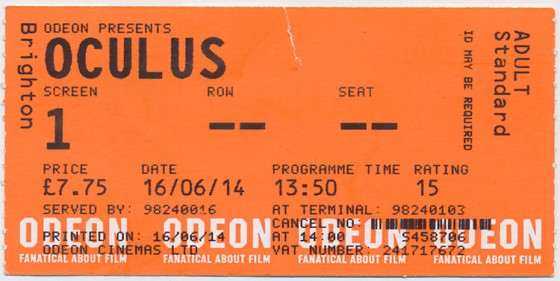Oculus

Blinkologist, pointograph thyself
Given my tentative audience of four doesn’t see horror movies, I have no moral quandary in describing a pretty good, then ruined scene, from Oculus. In the house where the creepy mirror of death can alter your reality, Ms. Karen Gillan picks up and apple next to a light bulb and bites. We know what’s happened, and it’s fucking scary. These are the rare parts of the film that work, and they works so well that it carries a lot of the film. The idea that we might be doing something else when we move or act or jump has a nightmare quality of deep horror. Yiiiikes!

Then, Mr. Mike Flanagan, who I was rather surprised to discover started work as an editor, pulls a fake out. The switch was itself a switch, and she was just eating an apple! Yiiiiawn!
And, thus Oculus is a disastrous mess with a few really, really good scenes, and that’s not so bad, though not so hot either. You have a chance for pretty good scares, taken away and brought back with no logic. There is a genuine dream quality that works very well within a horror context, that what we’re seeing might just be a trick to get the character to walk under a 16 ton weight or what have you, just as it might be a trick that it was a trick of a riddle inside an enigma inside a tostada wrap.
To clarify the conflict between the sublime and the subpar, here’s this weird thing that kept bothering me. Okay. There’s the evil death mirror that killed her family. She wants revenge on the mirror. That’s fine. She wants to prove to the world that it was a real ghost, so to speak. Also fine. And there’s some stuff about videotaping yourself when you think you’re doing one thing, but really doing another. Pretty decent. But why, I ask you, did you create an elaborate plot to steal a mirror from an auction house? I would understand that if you were poor, or if the mirror went for $2,000,000 (daVinci’s hairbrush of Satan’s gaze, which ‘might be the mythical basis for the great Right Side Part of 1613’ went for $1.7M last season at Christie’s) but you’re super rich, hence all the setup with video cameras and so on. For fifteen grand, why didn’t you just, uh, buy it?
Oh, I get it. Time limits. Syd Mead says Time Limits Are Good. What I mean is, it’s a cheap way to create ‘tension’. Oh my. What if the auction house finds out and charge you with an extremely minor crime?. You’ve got the mirror of death. It’s slightly scarier than my boss might yell at me.
It’s just odd, and the world’s easiest fix. You just ADR ‘Two…million…dollars!’ at the auction, and then it makes sense that even our erstwhile heiress couldn’t even afford it, and, in addition, you get some addition actual tension – who would pay that much for the mirror? And so the film, which follows a almost rhythmic quality of opportunity fulfilled then squandered.
If only there was a job that allowed you to change the sound and image of a film after it was shot, and a person familiar with that job so much that they even knew the name.
Spliceology. I’m pretty sure it’s called spliceology. But I’m not a pointographer or a clickastickter, so what do I know.
The Take

$2.45
Thoughts on Oculus

 [logo]
[logo]

“…the film…follows a[n] almost rhythmic quality of opportunity fulfilled then squandered.” Perfectly sums up my problem with most of the scary movies I see. And with almost all of 2015’s movies. I want to be scared! I don’t want opportunity fulfilled then squandered!
Re: the 2015 mediocrity thing: I think the whole Obama administration has been horrible for movies. Things were so awful and sinister under Bush that the only way we could express ourselves was in bleak, nihilistic, I Heart Huckabees-esque movies. People are too relieved and complacent under Obama. I heard the same thing happened in Spain during the Franco years. Good movies that is.
On one hand, fascism. On the other hand, stuff to complain about means good art.
I could go either way.